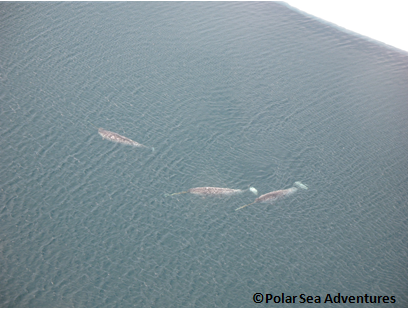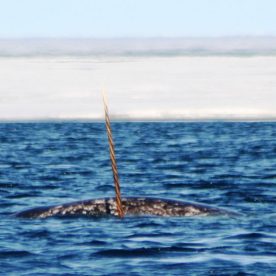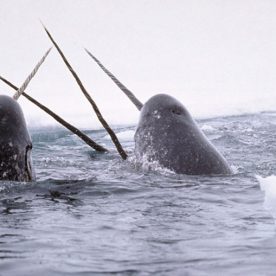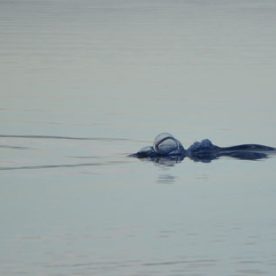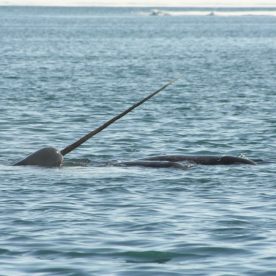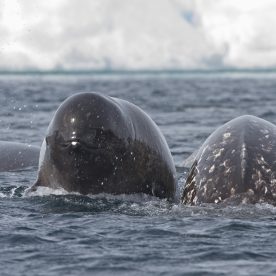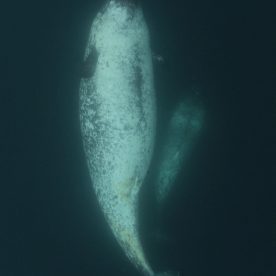Description
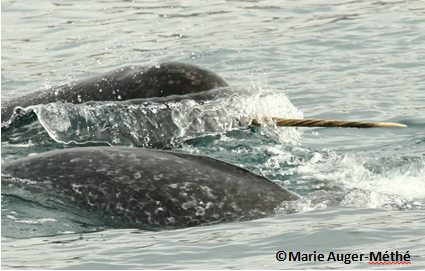
Narwhals (Monodon monoceros) are considered medium-sized odontocetes, or toothed whales (the largest being the sperm whale, and the smallest, the harbour porpoise), being of a similar size to the beluga, its close relative. Males can grow up to 6.2 m -the average size being 4.7 m- and weigh about 1,600 kg. Females tend to be smaller, with an average size of 4 m and a maximum size of 5.1 m and weigh around 900 kg. A newborn calf is about 1.6 m long and weighs about 80 kilograms. The narwhal has a deep layer of fat, or blubber, about 10 cm thick, which forms about one-third of the animal’s weight and acts as insulation in the cold Arctic waters.
Like belugas, they have a small head, a stocky body and short, round flippers. Narwhals lack a dorsal fin on their backs, but they do have a dorsal ridge about 5 cm high that covers about half their backs. This ridge can be used by researchers to differentiate one narwhal from another. It is thought that the absence of dorsal fin actually helps the narwhal navigate among sea ice. Unlike other cetaceans –the order which comprises all whales–, narwhals have convex tail flukes, or tail fins.
These whales have a mottled black and white, grey or brownish back, but the rest of the body (mainly its underside) is white. Newborn narwhal calves are pale grey to light brownish, developing the adult darker colouring at about 4 years old. As they grow older, they will progressively become paler again. The narwhal’s colouring gives researchers an idea about how old an individual is. Some may live up to 100 years, but most probably live to be 60 years of age.
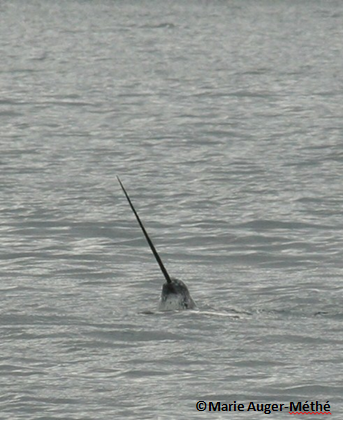
The narwhal’s most striking feature is undoubtedly its tusk. This long, spiral upper incisor tooth (one of the two teeth narwhals have) grows out from the animal’s upper jaw, and can measure up to 3 m and weigh up to 10 kg. Although the second, smaller incisor tooth often remains embedded in the skull, it rarely but on occasion develops into a second tusk. Tusks typically grow only on males, but a few females have also been observed with short tusks. The function of the tusk remains a mystery, but several hypotheses have been proposed. Many experts believe that it is a secondary sexual character, similar to deer antlers. Thus, the length of the tusk may indicate social rank through dominance hierarchies and assist in competition for access to females. Indeed, there are indications that the tusks are used by male narwhals for fighting each other or perhaps other species, like the beluga or killer whale. A high quantity of tubules and nerve endings in the pulp –the soft tissue inside teeth – of the tusk have at least one scientist thinking that it could be a highly sensitive sensory organ, able to detect subtle changes in temperature, salinity or pressure. Narwhals have not been observed using their tusk to break sea ice, despite popular belief. Narwhals do occasionally break the tip of their tusk though which can never be repaired. This is more often seen in old animals and gives more evidence that the tusk might be used for sexual competition. The tusk grows all throughout a male’s lifespan but slows down with age.
Habitat and Habits
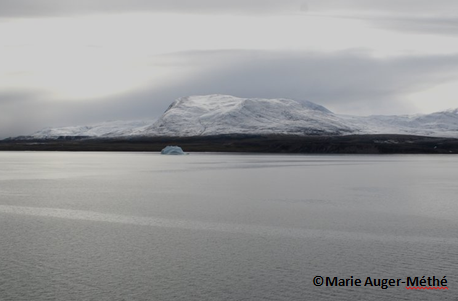
Fjords in Baffin Island, through which narwhals migrate between their wintering and summering areas
Habitat requirements of narwhals are little known. The fact that they remain year-round in Arctic waters, which are covered by sea ice for most of the year, makes the study of narwhal habitat somewhat difficult. But we do know that ice is important to the species, as it dictates migration patterns habits and habitat needs. Indeed, narwhals have adapted to live in these cold waters and rarely venture into warmer areas, where they would meet with more predators –like the killer whale– or have to compete with other whale species for food.
As ice conditions in the Arctic waters change from season to season, narwhals migrate on long distances – about 1,000 km or more – to different areas in the winter and the summer, following the fast ice –or ice that stays in place– growth or retreat. During their migration, hundreds, even thousands, of individuals may be seen travelling together, but otherwise narwhals tend to remain in smaller groups –or social units– of about three to eight individuals once in their summering or wintering areas. These groups are often comprised of same sex and similar aged individuals as well as mixed age-sex groups. Summering areas appear to be occupied by the same individuals every year, which suggest that there may be distinct populations that rarely mix.
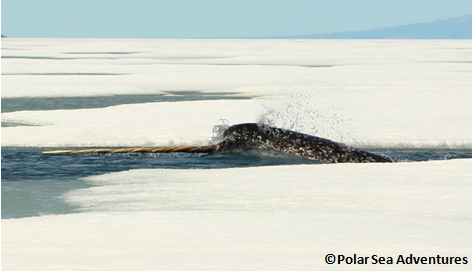
Narwhals generally spend winters –from November to April– in very deep, ice-covered waters where upwelling currents bring extra nutrients to the ecosystem. There, they spend much of their time in deep dives in search of food. The compact mobile ice at the surface provides protection from harsh seas and predators while providing access to air for breathing. Indeed, narwhals appear to select winter habitat with dense pack ice –areas where pieces of broken ice are floating at the surface of the sea– with small leads or cracks in the ice where they can surface. Even if narwhals are capable of traveling for a kilometre or more between breathing breaks, they need those cracks to have access to air. They also use the holes in the ice maintained by seals. If necessary, they can break through several centimetres of ice with their head or back. In the spring, narwhals head to the floe edge –or the edge of the fast ice field– and then wait for large leads to form in the ice to enter their summering areas.
In July and August, narwhals disperse over a vast region farther north, in the Canadian High Arctic archipelago. There, they group together in coastal areas in bays, island passages and fjords with access to deep open waters. There, they are sheltered from winds and predators, much like what the sea ice provides to them in the winter. They tend to spend more time near the surface than in the winter, and they make shorter, shallower dives. In the fall, narwhals form larger herds again and turn southwards before the coastal waters freeze. It takes about two months to complete their migration to their wintering areas.
As deep-diving cetaceans, narwhals are fully equipped to deal with long periods without oxygen in a high pressure environment. They have been known to dive to 1,500 m deep, with dives lasting 25 to 30 minutes. Their blood and muscles can hold more oxygen than most mammals, even many other whales, and they rely on their high number of blood vessels between their heart and lungs. Between dives, narwhals quietly spend long periods of time lying at the surface –a behaviour called “logging”– while they breathe heavily to restore their oxygen stores in preparation for the next dive.
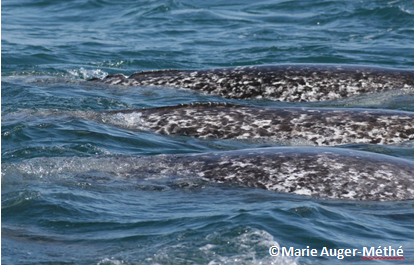 Narwhals are gregarious; they live in groups and communicate to each other by using whistles, squeaky hinge-like sounds, and many other noises which they produce by controlling the air passages near their blowholes. When socializing, males have been shown to use a greater “vocabulary”, or a bigger ranger of sounds, than females. Also, since very little light shines in the depths under the ice, narwhals use sound to investigate their environment. This process is called echo-location, which is also used by bats during the night. The whales get information about their surroundings by emitting clicks and knock sounds that resound and bounce off objects in the water. The melon, a fatty bump on their forehead, is used to focus and amplify these sounds. The echoes are captured by their hollow lower jaw and transmitted to their ears. Their brains then analyze these signals to get an idea of what’s around them and its distance. This process works like a sonar: when the clicks are of a lower pitch, narwhals have a greater the range of detection, but gather less details from the echoes. Higher pitch clicks give them greater detail about their surroundings but a lesser range.
Narwhals are gregarious; they live in groups and communicate to each other by using whistles, squeaky hinge-like sounds, and many other noises which they produce by controlling the air passages near their blowholes. When socializing, males have been shown to use a greater “vocabulary”, or a bigger ranger of sounds, than females. Also, since very little light shines in the depths under the ice, narwhals use sound to investigate their environment. This process is called echo-location, which is also used by bats during the night. The whales get information about their surroundings by emitting clicks and knock sounds that resound and bounce off objects in the water. The melon, a fatty bump on their forehead, is used to focus and amplify these sounds. The echoes are captured by their hollow lower jaw and transmitted to their ears. Their brains then analyze these signals to get an idea of what’s around them and its distance. This process works like a sonar: when the clicks are of a lower pitch, narwhals have a greater the range of detection, but gather less details from the echoes. Higher pitch clicks give them greater detail about their surroundings but a lesser range.
Another whale species shares the narwhal’s northern habitat and has much in common with it: the beluga. Although similar in some of their habits, these two odontocetes are very seldom in competition for resources such as food and space. Although they occupy the same regions and do overlap in range at times, the areas and timing where they group may differ. Also, because narwhals are able to dive much deeper, they have access to different food sources than their white relative. The third whale that has evolved to live year-round in the Arctic Ocean is the bowhead whale, but this much larger baleen whale is not in competition for resources with either the narwhal or the beluga, as its habits and prey species are very different. The major predator of the narwhal is the killer whale, while Greenland sharks, polar bears and walrus have on occasion been reported to prey upon it. When narwhals are caught in fast ice, they then become an easier target for polar bear predation.
Range
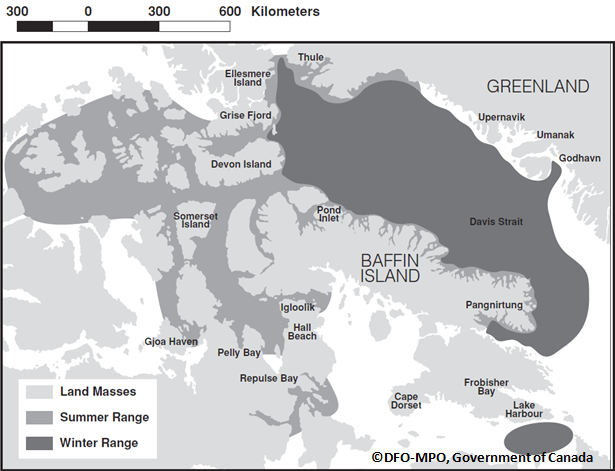
Range of narwhal populations in Arctic Canada (From Narwhal, Underwater World)
The narwhal is exclusively circumpolar –it lives in polar regions south of the North Pole–, and rarely ventures south of 60th parallel. It has been observed occasionally off the coasts of Labrador, Iceland and Norway, in the North Sea close to the British Isles, the Netherlands and Germany, along the arctic coast of Russia and in northern Alaska. But it is more common in the Canadian Arctic and Greenland. Three distinct populations of narwhals have been recognized throughout the world, and two of them occur in Canada: the Baffin Bay and the Hudson Bay populations. The first population winters in Baffin Bay and Davis Strait between Baffin Island all the way to West Greenland and occupies a range of at least 1.25 million km2. The second population spends its summers in Hudson Bay and winters in eastern Hudson Strait and western Davis Strait. It has a smaller range of about 250,000 km2. Because of site fidelity to summer calving areas, or the fact that individuals tend to return to the same areas year after year to give birth, these populations may in fact consist of several more sub-groups, but more research is necessary to find out if this is the case. The third narwhal population is found in the European Arctic, and does not enter Canadian waters.
Feeding
As is the case for many cetaceans, the narwhal’s diet varies from season to season. Some research has shown that it tends to feed heavily during its fall migration and in the winter, and less during the spring and summer. It also tends to rely on different food sources at different times throughout the year. In the summer, cod and squid are the most common food items, while during the winter, more Greenland halibut, or turbot, a deep water fish, is consumed along with squid. Shrimp are also part of the narwhal’s restricted diet. Although we know little about the species’ diet, experts estimate that a quantity of about 30 kg of food per day would be necessary for its survival.
Studies of the narwhal’s diet indicate that it can feed at a variety of depths, but in the low light under the ice and in the darkness of the deep waters, the narwhal uses echo-location to help spot its food. While hunting for pelagic fish or groundfish –or fish that live close to or on the ocean floor – the narwhal has been observed swimming upside down much of the time, which may help with navigating and feeding.
Breeding
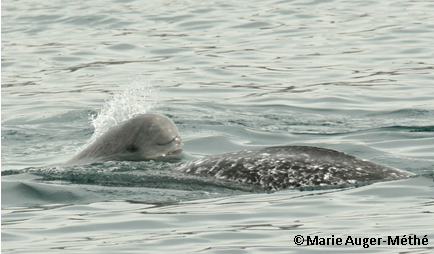
Narwhal and calf
Research suggests that female narwhals reach sexual maturity, or can start reproducing, at eight to twelve years of age, and males, at a much older age. Narwhals mate in the spring, from March to May, and females give birth during the summer of the following year. Thus, the gestation period is approximately 14 months long! Calves are born one at a time, and are nursed for about 20 months. As they are born with a very thin layer of blubber, they need their mothers’ milk, which is rich in fat, to develop the insulation and fat storage needed for winter survival in cold waters. During the nursing period, they stay in close contact with their mothers, where they can learn the skills they will need later in their lives. Most female narwhals can reproduce every three years, but many females give birth at longer intervals. This slow reproduction means that a population grows very slowly.
Conservation
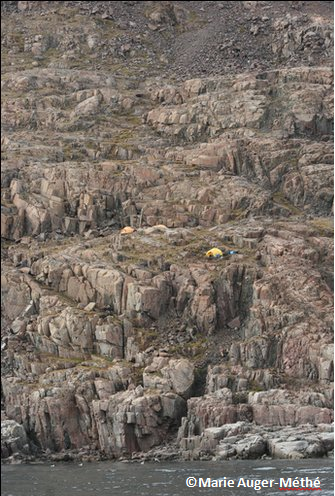
Scientist studying the narwhal from ashore
It is challenging to obtain a reliable estimate of the population for the two Canadian populations of narwhals because they spend much time underwater and the sea ice, have large ranges, and much of their wintering seasons are without light. Even so, recent data has estimated the Baffin Bay population to be between 60,000 and 80,000 individuals, while the Hudson population is comprised of about 5,000 animals or so. The number of individuals in the East Greenland population is about 10,000. These numbers demonstrate that the narwhal is not rare or at risk, unlike what is commonly thought. Even so, there are potential threats to this highly specialized species.
Unsustainable and non-traditional hunting may have an impact on narwhal populations, especially the smaller ones. Currently, only Inuit may hunt narwhal for subsistence, and they do so within a quota, or maximum number of catches. Recently, this type of management has been evolving towards a community-based system. This will re-establish more traditional ways of hunting while hopefully reducing losses during the hunt. As some animals end up injured but not recovered when hunted, these changes to hunting methods could improve population growth. The narwhal is hunted because of its vitamin C-rich skin, a meal called “maqtaq” in Inuktitut, but also because of its tusk. Narwhal tusks are valuable items on national and international markets. Since narwhals are listed under the Convention on International trade in Endangered Species (CITES), Inuit hunters need an export permit to sell tusks internationally. Within Canada, only tusks legally acquired during an Inuit hunt can be legally sold. Greenland has installed a ban in 2006 of all narwhal product exports, but before this ban, the only tusks that could be purchased in the European Union were gathered through Greenland Inuit hunts. An estimated 400 to 600 narwhals are hunted each year in Canada, and more studies are needed to know if this hunt, at this rate, is sustainable.
Ocean contaminants might also be a threat to the species. Heavy metals and other pollutants like pesticides tend to accumulate in the narwhals’ blubber and liver. This could cause health issues to narwhals and even to the humans that consume it. Another anthropogenic activity that could cause harm to the whale is fisheries. Large quantities of Greenland halibut, one of the narwhal’s staple foods, are harvested in Baffin Bay and Davis Strait, creating competition between humans and narwhals for the fish resource.
Climate change, and its impact on sea ice and water currents, could be detrimental to the narwhal due to the whale’s close association with ice. Both the disappearance and the increase of ice could have an impact on the species. In Baffin Bay, more winter ice has formed in the past 50 years than previously, leaving less leads or cracks for the narwhal to surface and breathe and increasing the chances of entrapment in ice. Other studies indicate that the ice is in fact disappearing, leaving more open water during the winter months and so more opportunities of killer whale predation. Changes in Arctic climate could bring about changes in narwhal prey distribution and migration patterns, along with disturbances from increasing ship traffic with the opening of the North-West Passage.
Because experts can only estimate the historical number of narwhals, population trends are currently unknown. Hence, it is challenging to assess the impact these potential threats, if any, are presently having on the species. Also, it is unclear how adaptable narwhals are to changes in their environment, especially variations in ice extent and duration. Because of this, the Committee on the Status of Endangered Wildlife in Canada (COSEWIC) has assessed the species as of Special Concern, but the species is not currently designated as At Risk under the Species at Risk Act (SARA).
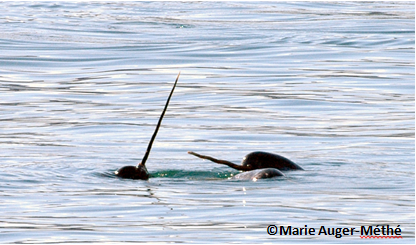 In order to fill the knowledge gaps that remain around this mysterious whale, researchers are currently trying to find out more about population dynamics, age structure, habitat needs and general biology of populations. Also, the movements of individuals are being tracked by satellite-linked transmitters, giving experts valuable information on whereabouts and feeding activities of the narwhals during the whole year, including winter months. Since Inuit have been observing narwhals for centuries, giving them a particular understanding of the species, both scientists and Inuit elders are putting their knowledge together to improve the overall knowledge of narwhal ecology and population biology, and even answer questions about the function of its tusk. It is important to have the best information about the narwhal. The more we know, the more efficient our efforts will be towards the conservation of the “Unicorn of the Sea”.
In order to fill the knowledge gaps that remain around this mysterious whale, researchers are currently trying to find out more about population dynamics, age structure, habitat needs and general biology of populations. Also, the movements of individuals are being tracked by satellite-linked transmitters, giving experts valuable information on whereabouts and feeding activities of the narwhals during the whole year, including winter months. Since Inuit have been observing narwhals for centuries, giving them a particular understanding of the species, both scientists and Inuit elders are putting their knowledge together to improve the overall knowledge of narwhal ecology and population biology, and even answer questions about the function of its tusk. It is important to have the best information about the narwhal. The more we know, the more efficient our efforts will be towards the conservation of the “Unicorn of the Sea”.
What we can do
There are easy things you can do to help conserve the narwhal:
- Be mindful of what you are pouring down the drain and the sewage system. Even if you live far away from the Arctic Ocean, contaminants can make their way North through your watershed and oceanic currents. Try to always use biodegradable cleaning products!
- Battle climate change by staying “green” in your energy use. For example, ride a bicycle instead of driving, close the lights when you exit a room or wear a sweater instead of turning the heating up during the winter.
Resources
Scientific Reviewers
Marie Auger-Méthé
PhD Candidate, University of Alberta
Dr. Steven Ferguson
Fisheries and Oceans Canada
Pierre Richard
Fisheries and Oceans Canada
Resources
National Geographic: Narwhal
https://www.nationalgeographic.com/animals/mammals/n/narwhal/
The narwhal: a Species at Risk in the North
http://www.dfo-mpo.gc.ca/species-especes/species-especes/narwhal-narval-eng.htm
WWF Narwhal Tracker
http://wwf.panda.org/what_we_do/where_we_work/arctic/wildlife/whales/narwhal/tracker/
Convention on Migratory Species, Narwhal
http://www.cms.int/reports/small_cetaceans/data/M_monoceros/m_monoceros.htm
Ice Unicorn, the Narwhal Expedition
http://whitelab.biology.dal.ca/mm/project.html
Narwhal Tusk Discoveries
http://www.narwhal.org/index.html
Lancaster Sound 2011 Arctic Whale Survey
http://oceansnorth.org/narwhal-belugas-and-bowhead
© Her Majesty the Queen in Right of Canada, represented by the Minister of the Environment, 2012. All rights reserved.
Text: Annie Langlois




